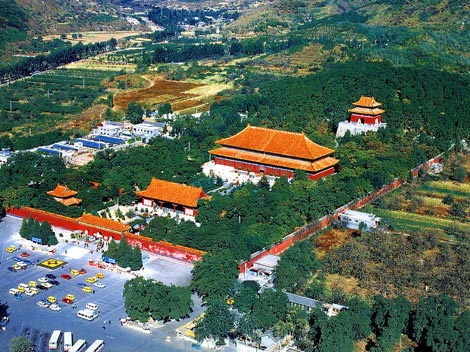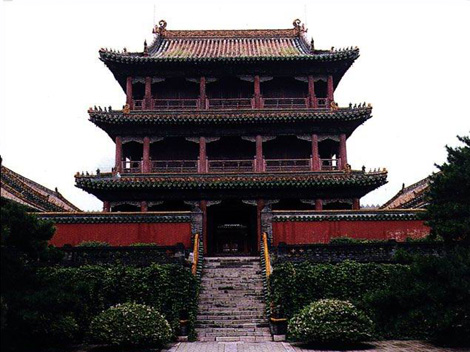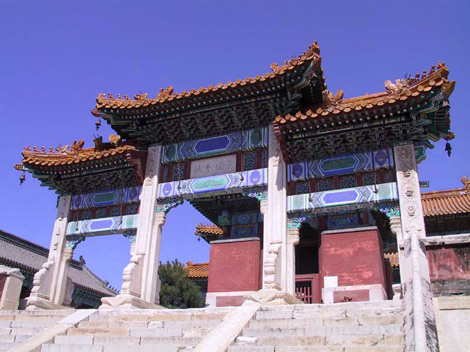more>>More News
- National Day
- ways to integrate into Chinese style life
- Should they be in the same university with me?!!
- Chinese Ping Pang Legend: the Sun Will Never Set
- A Glance of those Funny University Associations
- mahjong----The game of a brand new sexy
- Magpie Festival
- Park Shares Zongzi for Dragon Boat Festival
- Yue Fei —— Great Hero
- Mei Lanfang——Master of Peking Opera
Confucianism in Chinese Mausoleum
By admin on 2015-01-16
The mausoleum specifically refers to a type of
structure for burying emperors, with the top of the tomb smeared with mud. Such
tombs began appearing in an embryonic state during the Yin and Shang dynasties
(between the 21st and 11th centuries BC), before fully emerging during the
Warring States period (475-221 BC). From then on, through the Qin, Han, Tang,
Song and on to the Ming and Qing dynasties, great attention was always paid to
them. Born in the prehistoric period and worshipped by primitive ancestors, they
achieved refinement through the Confucianists and continued for more than 2,000
years. In terms of structures, mausoleums are the most important along with
"temples" for worshipping ancestors and sages. The Confucianists placed special emphasis on filial
piety in providing a stable foundation for maintaining the patriarchal social
order with blood lineage as the bond. They argued that, as long as people
personally practiced filial piety, they would not defy their Superiors and start
a rebellion. Filial piety applied not only during the lifetime of the family
elders but also after their death. The dead were treated exactly the same as the
living, through sacrifices, worship and reporting everything that happened, even
simple things like going out from or returning to the home. Such activities were
directed to the ancestors' memorial tablets. After their death, the tomb is
their residence in another world, called "yin (negative) residence" to which
full, and even more attention, should be paid than when the person occupied the
"yang (positive) residence". This was even more true in the case of imperial
mausoleums. According to the concept of the ancients, the terrain
and topography, direction and safety selected for the site of the yin residence
had long-term influence on the destiny of future generations. This is part of
what is known as "geomancy" in China. This emerged very early, and in the Wei,
Jin and on to the Tang Dynasty and even after that, geomancy increasingly
emphasized careful selection of the burial site and geomantic works were mostly
named "burial scriptures". Attention was paid to examining the topographic
features of mountains and rivers, and to the arrangement of direction and
position- Geomancy not only applies to tombs, although this is its greatest
role, but also influences various other structures in real life. Although there
are some unscientific and even anti-scientific factors in geomancy, its
attention to the selection of terrain and its site-selection principles often
conform to scientific and artistic laws. From the numerous tombs set up in light
of site selection in accordance with geomantic principles, it is not hard to see
its positive role. In ancient hierarchical society, there were, of
course, insurmountable differences in rank regarding tomb size. The Book of
Rites says: To follow the jaw of rites, one should, in various aspects, observe
the stipulations of quantity. For instance, in the size and quantity of palatial
halls, houses or utensils, the thickness of the coffin, and the size of the
grave, rank should be clearly defined. The more respectable the person, the
bigger the tomb and the more graves were set up for them. The most important
thing expressing one's rank was the size of the grave, and size has always been
a vitally important factor in architectural art. The major difference between architectural art and
other arts in terms of the method of appeal is that the former has unmatched
tremendous size in structure. From the high mountains and large rivers, tall
trees and huge rocks of nature, ancients experienced the loftiness contained in
exceptional size. And from the thunder and lightning, the raging tide and the
roaring fire they felt the fear contained in the superhuman strength. When these
experiences were transplanted into construction, hugeness was transformed into
dignity and importance. Therefore, the grave of the monarch was particularly
high and large, and was called either a "mausoleum" or "imperial tomb". The
original meaning of "mausoleum" was a high and big mountain. The graves for
other persons, being smaller, were called "graves", "tablets" or "tombs" and
referred merely to an earth mound. From the Qin and Han until the Ming and Qing
dynasties, the emperors' tombs were always covered with a huge mound. Great achievements were made in the combination of
natural environment during the Tang Dynasty, and the vast scene was given strong
memorial character. There was a distinguishing feature in the Tang dynasty
mausoleum, in that the entire mausoleum district was modeled on the capital
city. The design of the mausoleum, like the capital city, was permeated with
ritual logic, so as to give prominence to the dignity of the imperial
authority. The Ming and Qing dynasties paid still higher
attention to, and recorded still greater achievements, in the application of
geomancy. Their shape and structure were somewhat different from those witnessed
in the Han, Tang and Song dynasties, the Ming Tombs and the East and West
Mausoleums of the Qing Dynasty being famous examples. The Tang Dynasty witnessed the second climax in the
construction of mausoleums in China, following Qin and Han dynasties. There are
18 mausoleums on the northern bank of the Weishui River inShanxi
Province. Tang Dynasty imperial mausoleums are mostly built at
the foot of mountains. Tombs were set up in the rocks on naturally isolated
mountains, and their great momentum Surpassed manually earth-sealed graves. Take
Qianling, where Emperor Gaozong is buried' together with Wuzetian, for example.
Qianling is about 70 meters above the path leading to tombs before the
mausoleum, and so is much more magnificent than Qin and Han dynasty grave mounds
which generally are only 20-30 meters above the path. The various tombs take
Beishan Mountain as the background, with their south face pointing across the
vast central Shanxi plain. These tombs, and the distant Zhongnan and Taibai
mountains, face one another. The Weishui River lies horizontally before them,
and the Jingshui River meanders between them. In the vicinity are shallow
ditches and deep gullies. Looking ahead, one finds a stretch of flat land, which
serves as a foil to the height and prominence of the main peak of the mausoleum
mountain. Tang Dynasty tombs inherited and even developed the
tradition of Han Dynasty tombs, with doors on four sides, forming a magnificent
picture of the superficial characteristics of an imperial residence. Square
walls were built around the mausoleum hills, called the inner city. In the
middle of the four sides are doors, with an arched gateway. In the four corners
are watchtowers. Within the Zhuque (rose finch) Gate, which is the south gate,
is a worship hall where grand worship ceremonies were held. Outside the Zhuque
Gate is a 3-4 km-long path leading to the tombs, At the southernmost end is a
pair of earthen watchtowers, behind which is a door, from which one goes
northward to reach the second pair of earthen water towers and the second door,
several hundred meters from the Zhuque Door. From there, one goes further to the
third pair of earthen water towers in front of the Zhuque Door. In the vast area
between the first and second layer of doors are scattered numerous Subordinated
tombs. The greatest number of these, 167, are in the Zhaoling Mausoleum of
Emperor Taizong. Zhaoling Mausoleum and Zhenling Mausoleum of Emperor
Xuanzong have a circumference of 60 km. The scope of the entire mausoleum area
is very great, Surpassing the walled city of Chang'an. Second comes the Qianling
Mausoleum, with a circumference of 40 km, equivalent to Chang'an. And then come
various tombs with circumferences ranging from 10-30 km. Among the various
tombs, the Qianling Mausoleum is best preserved. The stone carvings of Tang
dynasty tombs is splendid. Arranged on both sides of the path leading to the
tombs are stone carvings, Such as stone pillars, winged horses, ostriches, stone
horses and persons leading horses, as well as stone figures. In addition, in the
Qianling Mausoleum between the stone figures and the third watchtower, there are
a characterless tablet and a recorded tablet narrating the history of a
sage. Between the third water tower and the stone lion in
front of the north Zhuque Gate on the left and right sides, there are a total of
61 statues of guests of the king. The east, west and north gates in the inner
city are like the south gate, with a pair of stone lions and a pair of earthen
watch towers. outside the earthen watchtowers at the north gate are added three
pairs of horses, called "six dragons", indicating they are the inner stables of
the imperial palace. pine, cypress, Chinese scholar tree and poplar are widely
planted in side the mausoleum district, setting off the stone carving which,
undoubtedly has enriched the content of the mausoleum district and expanded the
control space of the mausoleum district, contrasting the height and grandeur of
the mausoleum hill, and playing a great role in playing up the atmosphere of
dignity and nobility. It can be seen that this mausoleum system is
identical with the planning idea of the city of Chang'an. The entire mausoleum
area is equivalent to the walled city; the Subordinated tombs are in the
suburbs' the area stretching northward from the second door is equivalent to the
imperial city; the stone figures and stone lions symbolize the guards of honor
posted when the emperor goes out; the "inner city" inside the Zhuque gate is
equivalent to the palatial city. The design of the mausoleum, like the design of
the capital city, is permeated with strict ritual system logic, both designed to
give prominence to the dignity of imperial power.

 The Qinshihuang
Mausoleum in Lintong, Shanxi, is the largest mausoleum of the Qin and Han
dynasties. The earth mound is square, each side measuring about 350 meters, and
resembling the Egyptian pyramids in the form of a three-layer square pyramid
platform ail piled up manually. The existing remnant is still 43 meters high.
The top is vast, flat and smooth, and royal halls were possibly once built on
it. There are two layers of mausoleum walls around it, with doors opening on all
four sides. The north door is possibly taken as the front gate. The southern
part of the mausoleum rests on Lishan Mountain and its north faces the Weihe
River The terrain is high in the south and low in the north, with the north door
taken as the front gate, so that the Lishan Mountain becomes the natural
background of the mausoleum.
The Qinshihuang
Mausoleum in Lintong, Shanxi, is the largest mausoleum of the Qin and Han
dynasties. The earth mound is square, each side measuring about 350 meters, and
resembling the Egyptian pyramids in the form of a three-layer square pyramid
platform ail piled up manually. The existing remnant is still 43 meters high.
The top is vast, flat and smooth, and royal halls were possibly once built on
it. There are two layers of mausoleum walls around it, with doors opening on all
four sides. The north door is possibly taken as the front gate. The southern
part of the mausoleum rests on Lishan Mountain and its north faces the Weihe
River The terrain is high in the south and low in the north, with the north door
taken as the front gate, so that the Lishan Mountain becomes the natural
background of the mausoleum.
- Contact Us
-
Tel:
0086-571-88165708
0086-571-88165512E-mail:
admission@cuecc.com
- About Us
- Who We Are What we do Why CUECC How to Apply
- Address
- Study in China TESOL in China
Hangzhou Jiaoyu Science and Technology Co.LTD.
Copyright 2003-2024, All rights reserved




 Chinese
Chinese
 English
English
 Korean
Korean
 Japanese
Japanese
 French
French
 Russian
Russian
 Vietnamese
Vietnamese
